Erosion Control in the Sustainable Cultivation of Maize (Zea mays L.) and Beans (Phaseolus vulgaris L.) at Two Stages of the Agricultural Cycle in Southern Guatemala
Abstract
1. Introduction
2. Materials and Methods
2.1. Site Characteristics
2.2. Tillage and Crop Management
2.3. Methods
3. Results
3.1. Crop Canopy and Ground Cover
3.2. Soil Erosion at 3 and 6 Months after Sowing
3.3. Erosion-Related Soil Cover Variables
3.4. Erosion Threshold in Relation to the Ground Cover by Weeds and Litter in Maize–Bean Crops at 6 Months after Sowing
4. Discussion
5. Conclusions
Author Contributions
Funding
Acknowledgments
Conflicts of Interest
References
- FAO. The State of Food-Based Dietary Guidelines in Latin America and the Caribbean; FAO: Rome, Italy, 2014; Available online: http://www.fao.org/3/a-i3677s.pdf (accessed on 10 January 2018). (In Spanish)
- FAO. Food and Agriculture Organization of the United Nations, FAOSTAT, 2017. Available online: http://data.un.org/Explorer.aspx?d=FAO (accessed on 15 October 2017).
- Klepek, J. Selling Guatemala’s next Green Revolution: Agricultural modernization and the politics of GM maize regulation. Int. J. Agric. Sustain. 2012, 10, 117–134. [Google Scholar] [CrossRef]
- Foley, J.A.; DeFries, R.; Asner, G.P.; Barford, C.; Bonan, G.; Carpenter, S.R.; Chapin, F.S.; Coe, M.T.; Daily, G.C.; Gibbs, H.K.; et al. Global consequences of land use. Science 2005, 309, 570–574. [Google Scholar] [CrossRef] [PubMed]
- FAO. The State of the World’s Land and Water Resources for Food and Agriculture. Managing Systems at Risk; Food and Agriculture Organization of the United Nations (FAO): Rome, Italy; Earthscan: London, UK, 2011; p. 285. Available online: http://www.fao.org/docrep/017/ i1688e/i1688e.pdf (accessed on 6 December 2017).
- El-Swaify, S.A. Factors affecting soil erosion hazards and conservation needs for tropical steeplands. Soil Technol. 1997, 11, 3–16. [Google Scholar] [CrossRef]
- Nyssen, J.; Poesen, J.; Deckers, J. Land degradation and soil and water conservation in tropical highlands. Soil Tillage Res. 2009, 103, 197–202. [Google Scholar] [CrossRef]
- Labrière, N.; Locatelli, B.; Laumonier, Y.; Freycon, V.; Bernoux, M. Soil erosion in the humid tropics: A systematic quantitative review. Agric. Ecosyst. Environ. 2015, 203, 127–139. [Google Scholar] [CrossRef]
- Augustine, C.M.J.; Vogt, K.A.; Harrison, R.B.; Hunsaker, H.M. Nitrogen-fixing trees in small-scale agriculture of mountainous southeast Guatemala. J. Sustain. For. 2007, 23, 61–80. [Google Scholar] [CrossRef]
- Wuddivira, M.N.; Stone, R.J.; Ekwue, E.I. Influence of cohesive and disruptive forces on strength and erodibility of tropical soils. Soil Tillage Res. 2013, 133, 40–48. [Google Scholar] [CrossRef]
- Fernandes, E.C.M.; Motavalli, P.P.; Castilla, C.; Mukurumbira, L. Management control of soil organic matter dynamics in tropical land-use systems. Geoderma 1997, 79, 49–67. [Google Scholar] [CrossRef]
- Lal, R. Soil erosion impact on agronomic productivity and environment quality. Crit. Rev. Plant Sci. 1988, 17, 319–464. [Google Scholar] [CrossRef]
- Campbell, L.C. Managing soil fertility decline. J. Crop Prod. 1998, 1, 29–52. [Google Scholar] [CrossRef]
- Pimentel, D.; Harvey, C.; Resosudarmo, P.; Sinclair, K.; Kurz, D.; McNair, M.; Crist, S.; Shpritz, L.; Fitton, L.; Saffouri, R.; et al. Environmental and economic costs of soil erosion and conservation benefits. Science 1995, 267, 1117–1123. [Google Scholar] [CrossRef] [PubMed]
- Öborn, I.; Vanlauwe, B.; Atta-Krah, K.; Thomas, T.; Phillips, M.; Schut, M. Integrated systems research for sustainable intensification of smallholder agriculture. In Sustainable Intensification in Smallholder Agriculture: An Integrated Systems Research Approach; Öborn, I., Atta-Krah, K., Phillips, M., Thomas, R., Vanlauwe, B., Brooijmans, W., Eds.; Routledge: London, UK; Earthscan Food and Agriculture: New York, NY, USA, 2017; pp. 32–46. [Google Scholar]
- Aguilar, E.; Peterson, T.C.; Ramírez, P.; Frutos, R.; Retana, J.A.; Solera, M.; Soley, J.; González, I.; Araujo, R.M.; Rosa, A.; et al. Changes in precipitation and temperature extremes in Central America and northern South America, 1961–2003. J. Geophys. Res. 2005, 110, D23107. [Google Scholar] [CrossRef]
- IPCC. Global Warming of 1.5 °C. Chapter 3: Impacts of 1.5 °C Global Warming on Natural and Human Systems; Intergovernmental Panel on Climate Change: Geneva, Switzerland, 2018; Available online: https://www.ipcc.ch/pdf/special-reports/sr15/sr15_chapter3.pdf (accessed on 10 November 2018).
- Neelin, J.D.; Münnich, M.; Su, H.; Meyerson, J.E.; Holloway, C.E. Tropical drying trends in global warming models and observations. Proc. Natl. Acad. Sci. USA 2006, 103, 6110–6115. [Google Scholar] [CrossRef] [PubMed]
- Hoyos, C.D.; Agudelo, P.A.; Webster, P.J.; Curry, J.A. Deconvolution of the factors contributing to the increase in global hurricane intensity. Science 2006, 312, 94–97. [Google Scholar] [CrossRef] [PubMed]
- Kang, M.S.; Banga, S.S. Global agriculture and climate change. J. Crop Improv. 2013, 27, 667–692. [Google Scholar] [CrossRef]
- Hertel, T.W.; Burke, M.B.; Lobell, D.B. The poverty implications of climate-induced crop yield changes by 2030. Glob. Environ. Chang. 2010, 20, 577–585. [Google Scholar] [CrossRef]
- Lee, D.R.; Edmeades, S.; De Nys, E.; McDonald, A.; Janssen, W. Developing local adaptation strategies for climate change in agriculture: A priority-setting approach with application to Latin America. Glob. Environ. Chang. 2014, 29, 78–91. [Google Scholar] [CrossRef]
- Jones, P.G.; Thornton, P.K. The potential impacts of climate change on maize production in Africa and Latin America in 2055. Glob. Environ. Chang. 2003, 13, 51–59. [Google Scholar] [CrossRef]
- Blanco, R.; Aguilar, A. Soil erosion and erosion thresholds in an agroforestry system of coffee (Coffea arabica) and mixed shade trees (Inga spp. and Musa spp.) in Northern Nicaragua. Agric. Ecosyst. Environ. 2015, 210, 25–35. [Google Scholar] [CrossRef]
- Blanco, R.; Aguilar, A. The erosion threshold for a sustainable agriculture in cultures of bean (Phaseolus vulgaris L.) under conventional tillage and no-tillage in Northern Nicaragua. Soil Use Manag. 2016, 32, 368–380. [Google Scholar] [CrossRef]
- Blanco, R. An erosion control and soil conservation method for agrarian uses based on determining the erosion threshold. MethodsX 2018, 5, 761–772. [Google Scholar] [CrossRef] [PubMed]
- Hartemink, A.E. Soils are back on the global agenda. Soil Use Manag. 2008, 24, 327–330. [Google Scholar] [CrossRef]
- Eakin, H.; Lemos, M.C. Adaptation and the state: Latin America and the challenge of capacity-building under globalization. Glob. Environ. Chang. 2006, 16, 7–18. [Google Scholar] [CrossRef]
- Eakin, H.; Lemos, M.C. Institutions and change: The challenge of building adaptive capacity in Latin America. Glob. Environ. Chang. 2010, 20, 1–3. [Google Scholar] [CrossRef]
- FAO. Visual Soil Assessment. Field Guides; FAO: Rome, Italy, 2008; Available online: http://www.fao.org/docrep/010/i0007e/i0007e00.htm (accessed on 10 September 2017).
- Morgan, R.P.C. Soil Erosion and Conservation, 3rd ed.; Blackwell Publishing Ltd.: Hoboken, NJ, USA, 2005. [Google Scholar]
- FAO-ISRIC-ISSS. World Reference Base for Soil Resources; World Soil Resources Report; Food and Agriculture Organization of the United Nations: Rome, Italy, 1998; Volume 84. [Google Scholar]
- Enz, M.; Dachler, C. Compendium of Growth Stage Identification Keys for Mono- and Dicotyledonous Plants. Extended BBCH scale. AgrEvo-Basf-Bayer-Novartis. 1997. Available online: http://www.gartneriraadgivningen.dk/upl/website/bbch-skala/scaleBBCH.pdf (accessed on 9 November 2018).
- Bergsma, E.; Charman, P.; Gibbons, F.; Hurni, H.; Moldenhauer, C.C.; Panichapong, S. Terminology for Soil Erosion and Conservation; ISSS-ITC-ISRIC: Wageningen, The Netherlands, 1996; Available online: http://library.wur.nl/isric/fulltext/isricu_i24693_001.pdf (accessed on 10 September 2017).
- Stocking, M.; Murnaghan, N. Handbook for the Field Assessment of Land Degradation; Earthscan Pub. Ltd.: London-Sterling, VA, USA, 2001. [Google Scholar]
- Brandt, J. The transformation of rainfall energy by a tropical rain-forest canopy in relation to soil-erosion. J. Biogeogr. 1988, 15, 41–48. [Google Scholar] [CrossRef]
- Van Dijk, P.M.; Van der Zijp, M.; Kwaad, F.J.P.M. Soil erodibility parameters under various cropping systems of maize. Hydrol. Process. 1996, 10, 1061–1067. [Google Scholar] [CrossRef]
- Bravo-Espinosa, M.; Mendoza, M.E.; Medina-Orozco, L.; Prat, C.; García-Oliva, F.; López-Granados, E. Runoff, soil loss, and nutrient depletion under traditional and alternative cropping systems in the transmexican volcanic belt, Central Mexico. Land Degrad. Dev. 2009, 20, 640–653. [Google Scholar] [CrossRef]
- Barthès, B.; Azontonde, A.; Boli, B.Z.; Prat, C.; Roose, E. Field-scale run-off and erosion in relation to topsoil aggregate stability in three tropical regions (Benin, Cameroon, Mexico). Eur. J. Soil Sci. 2000, 51, 485–495. [Google Scholar] [CrossRef]
- Rachman, A.; Anderson, S.H.; Gantzer, C.J.; Thompson, A.L. Influence of long-term cropping systems on soil physical properties related to soil erodibility. Soil Sci. Soc. Am. J. 2003, 67, 637–644. [Google Scholar] [CrossRef]
- Derpsch, R.; Sidiras, N.; Roth, C.H. Results of studies made from 1977 to 1984 to control erosion by cover crops and no-tillage techniques in Paraná, Brazil. Soil Tillage Res. 1986, 8, 253–263. [Google Scholar] [CrossRef]
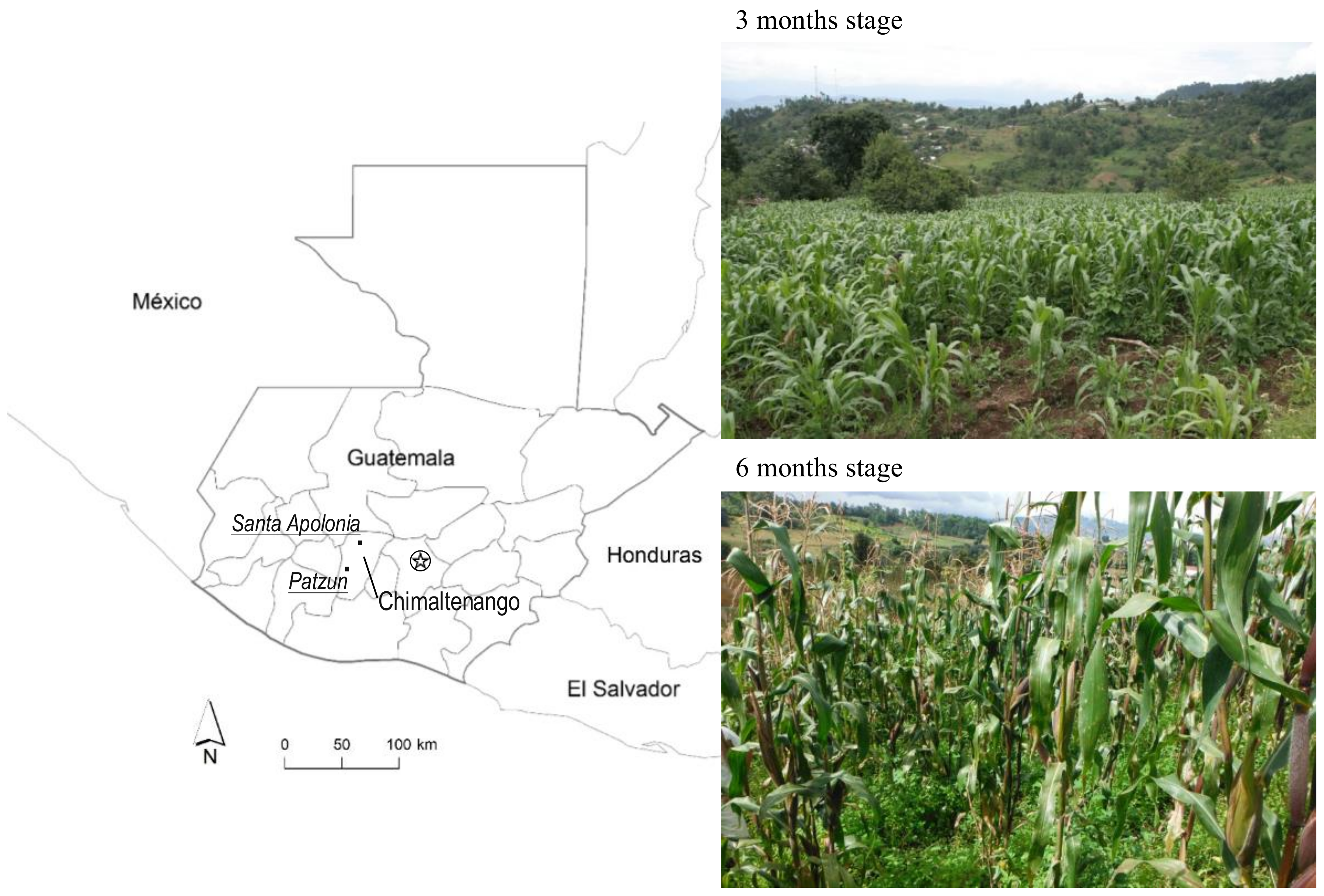

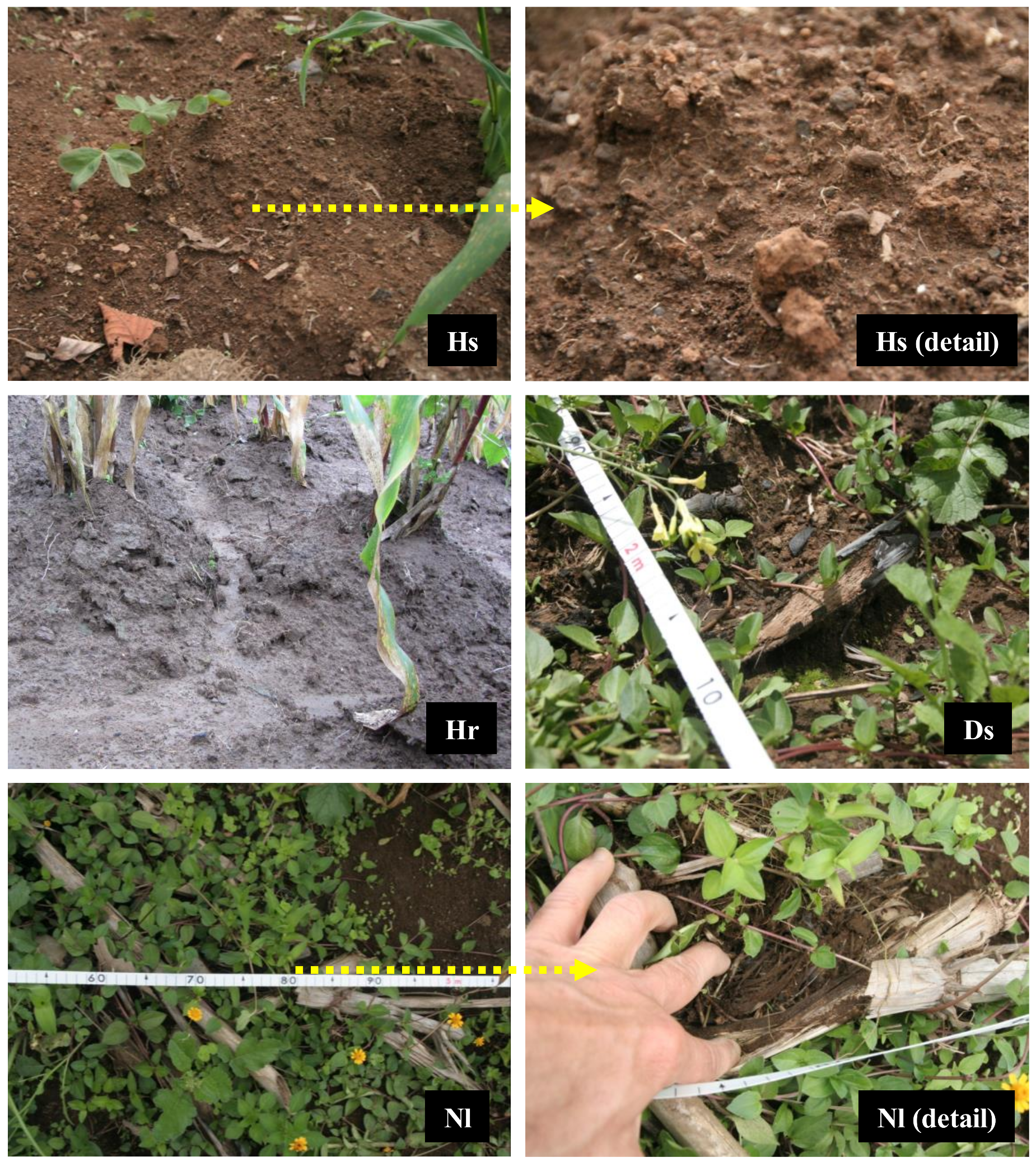
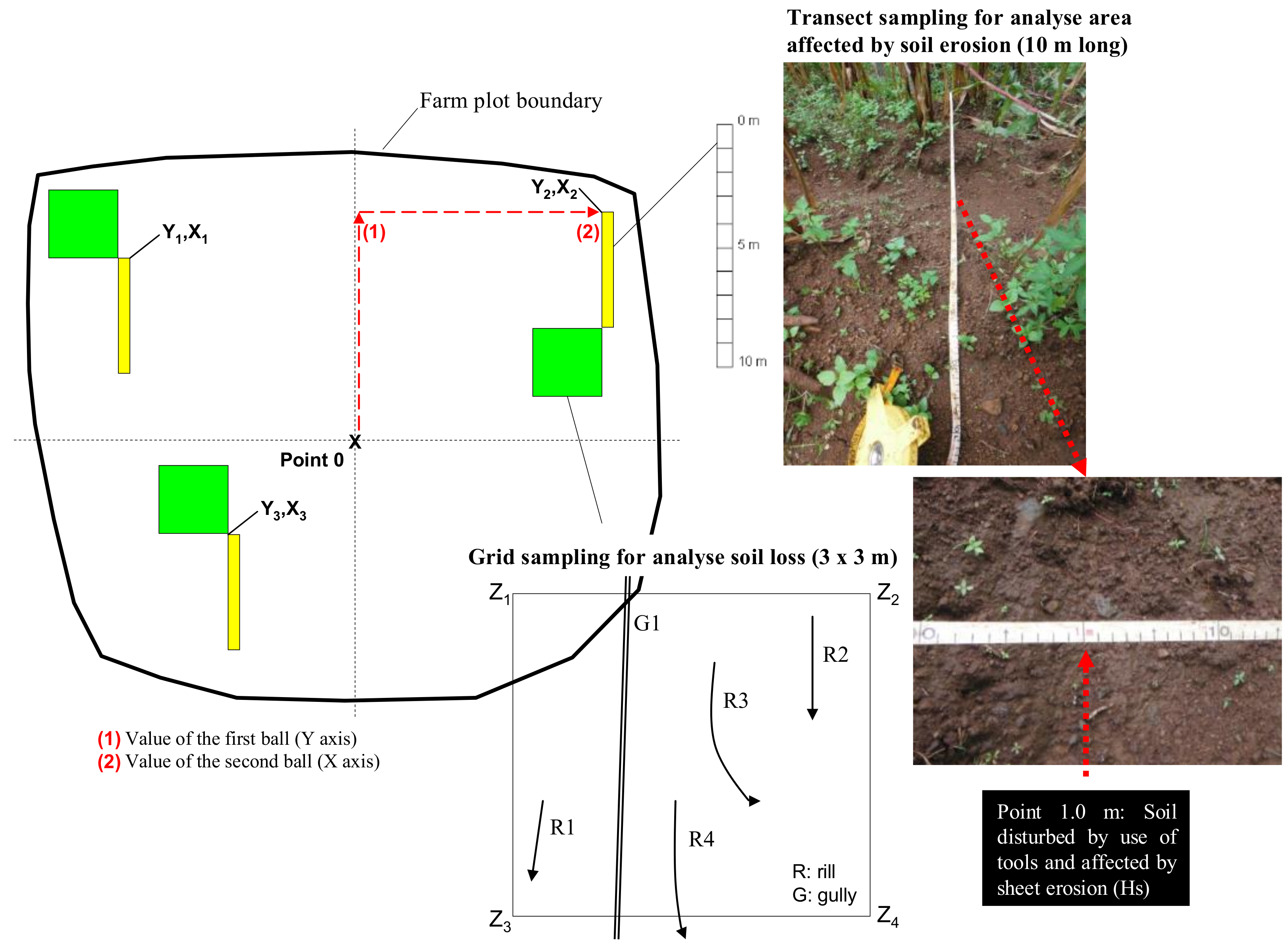
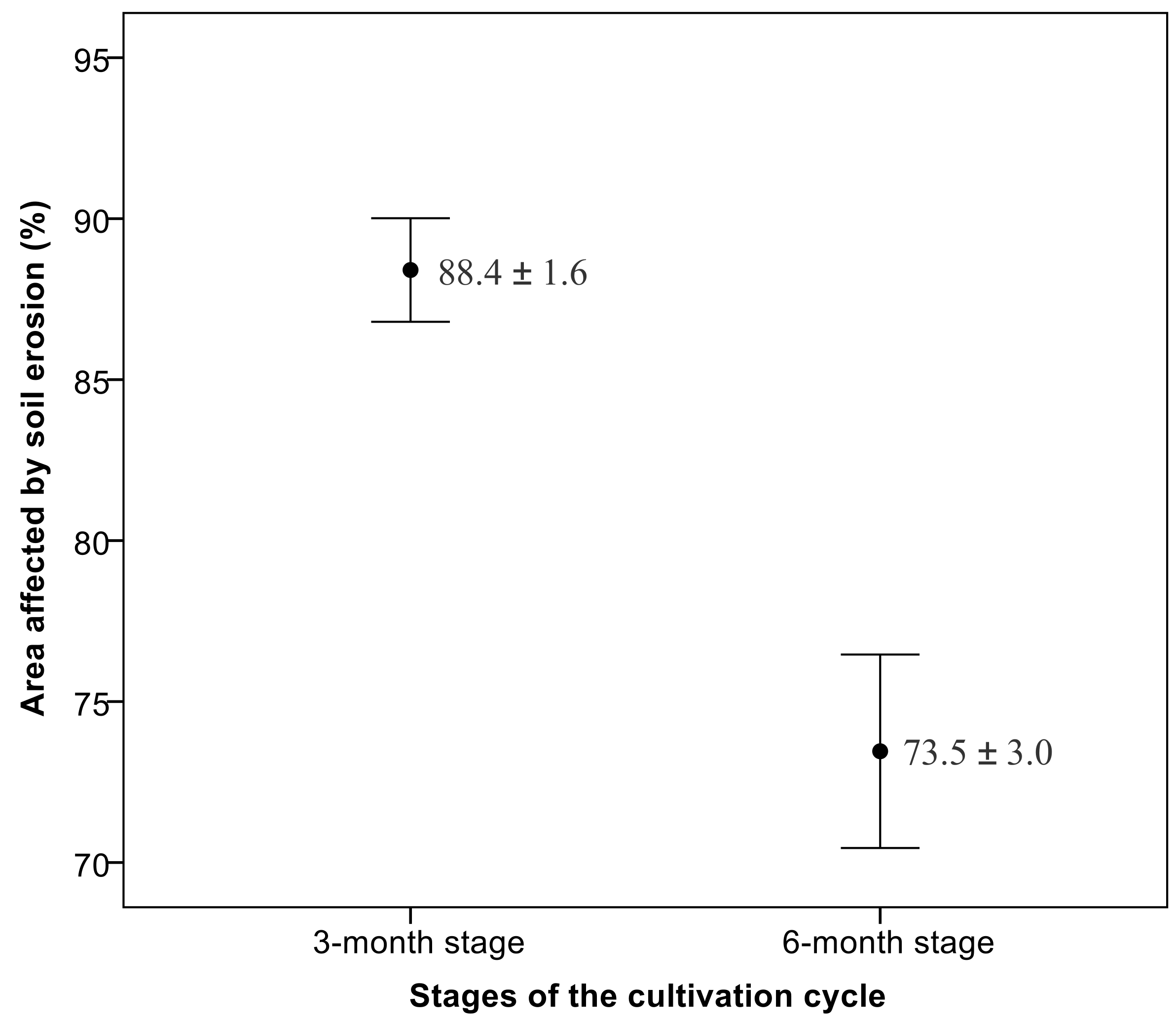
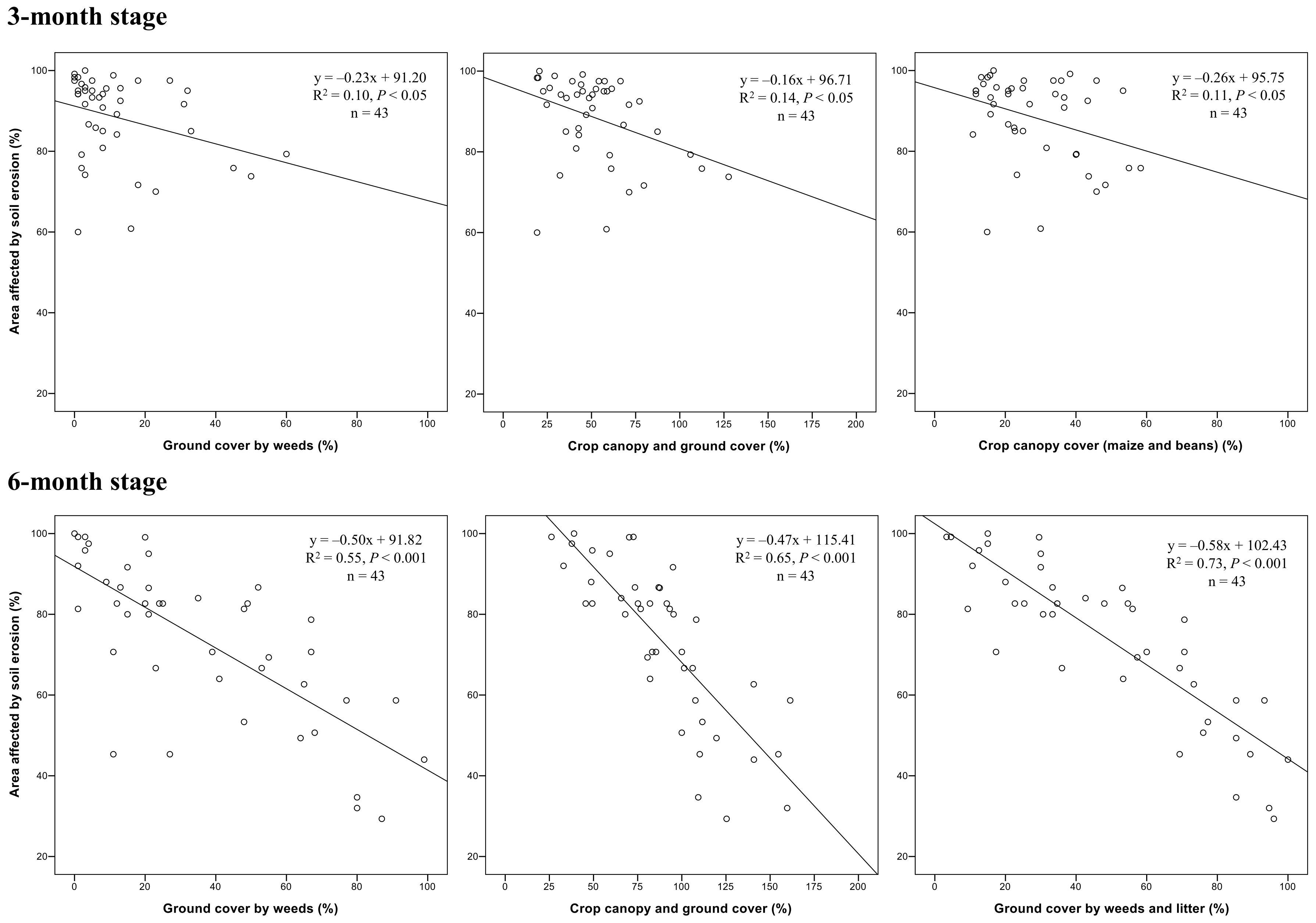
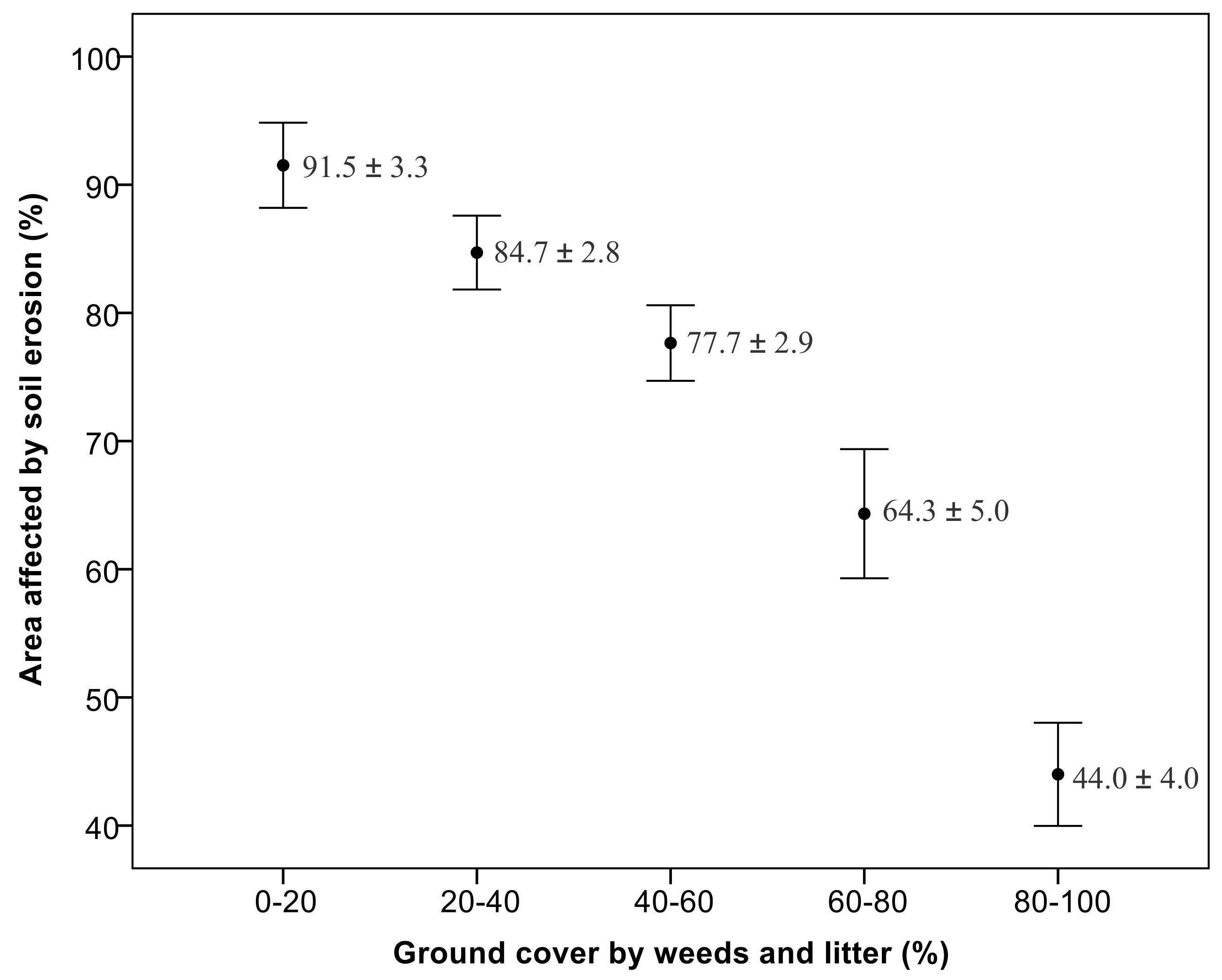

| T. Mechanical soil disturbance by trampling, affected by erosion, or erosion-susceptible |
| 1. (Tes) Soil disturbed by trampling and susceptible to erosion (but not visible at present) |
| 2. (Ti/Ts/Tr/Tg) Soil disturbed by trampling and affected by splash erosion (raindrop impact)/by sheet erosion/by erosion in rills/by erosion in gullies |
| H. Mechanical soil disturbance by tool (hoe), affected by erosion, or erosion-susceptible |
| 1. (Hes) Soil disturbed by tool use and susceptible to erosion (but not visible at present) |
| 2. (Hi/Hs/Hr/Hg) Soil disturbed by tool use and affected by splash erosion (raindrop impact)/by sheet erosion/by erosion in rills/by erosion in gullies |
| D. Soil deposition affected by erosion or erosion-susceptible |
| 1. (Des) Soil deposition susceptible to erosion (but not visible at present) |
| 2. (Di/Ds/Dr/Dg) Soil deposition affected by splash erosion (raindrop impact)/by sheet erosion/by erosion in rills/by erosion in gullies |
| N. No erosion |
| 1. (Nw) No evidence of erosion beneath cover of weeds |
| 2. (Nl) No evidence of erosion beneath litter layer |
| O. Others |
| 1. (Or) Stones |
| 2. (Oa) Animals: tracks, faeces, carcasses, others. |
| Class (cod) | Intensity of Erosion | Explanation |
|---|---|---|
| 0 | None/very slight | The soil is not affected or is only slightly affected by erosion. In the latter case, it is not immediately apparent. Evidence of erosion is occasional and only present in certain specific places, such as at the base of trees, bushes, or rocks. |
| 1 | Slight | The soil is somewhat affected by erosion, and this is clearly visible throughout the plot. The evidence of erosion is more widespread and also more apparent than in the previous case, but is only clearly concentrated in very specific locations. |
| 2 | Moderate | The soil is clearly affected by a moderate degree of erosion. Evidence of erosion is widespread and may be concentrated at any point on the plot, but the majority of the surface area remains unaffected by erosion. |
| 3 | Severe | The soil is strongly affected by erosion. The majority of the surface area is affected by erosion (in case of doubt, the plot is classified as Class 2). |
| Characteristics | Abbreviation | 3-Month Stage | 6-Month Stage |
|---|---|---|---|
| Mean ± Standard Error | Mean ± Standard Error | ||
| Crop canopy cover (maize and bean) (%) | CC | 28.1 ± 2.0 | 38.8 ± 2.5 |
| Ground cover by weeds (%) | GCW | 11.9 ± 2.2 | 36.4 ± 4.4 |
| Ground cover by litter (%) | GCL | 12.2 ± 1.5 | 13.3 ± 1.9 |
| Ground cover by weeds and litter (%) | GCW-L | 24.1 ± 2.9 | 49.7 ± 4.4 |
| Crop canopy and ground cover (%) | CC–GCW-L | 52.2 ± 3.8 | 88.6 ± 5.1 |
| Surface Processes and Actions | Abbreviation | 3-Month Stage | 6-Month Stage |
|---|---|---|---|
| Mean ± Standard Error | Mean ± Standard Error | ||
| Soil disturbed by trampling and susceptible to erosion (but no erosion currently visible) (%) | Tes | 1.0 ± 0.2 | 0.1 ± 0.1 |
| Soil disturbed by trampling and affected by sheet erosion (%) | Ts | 0.3 ± 0.1 | 0 |
| Soil disturbed by hoe and susceptible to erosion (but no erosion currently visible) (%) | Hes | 3.2 ± 1.2 | 0.1 ± 0.1 |
| Soil disturbed by hoe and affected by splash erosion (%) | Hi | 15.2 ± 2.9 | 12.3 ± 2.2 |
| Soil disturbed by hoe and affected by sheet erosion (%) | Hs | 50.5 ± 1.9 | 51.9 ± 2.0 |
| Soil disturbed by hoe and affected by rill erosion (%) | Hr | 1.0 ± 0.2 | 0.2 ± 0.2 |
| Soil deposition susceptible to erosion (but no erosion currently visible) (%) | Des | 2.9 ± 0.8 | 1.9 ± 0.4 |
| Soil deposition affected by splash erosion (%) | Di | 0.5 ± 0.4 | 0.5 ± 0.2 |
| Soil deposition affected by sheet erosion (%) | Ds | 21.1 ± 3.0 | 8.5 ± 1.1 |
| No evidence of erosion beneath cover of weeds (%) | Nw | 1.1 ± 0.6 | 9.3 ± 1.9 |
| No evidence of erosion beneath litter layer (%) | Nl | 3.4 ± 0.7 | 12.6 ± 1.9 |
| Other topsoil characteristics (stones) (%) | Or | 0 | 2.5 ± 0.6 |
| Area affected by soil erosion (total) (%) | Et | 88.4 ± 1.6 | 73.5 ± 3.0 |
| Area presenting no evidence of erosion (total) (%) | Ene | 11.6 ± 1.6 | 24.0 ± 3.0 |
| Soil loss (m3 ha−1) | Esl | 1.5 ± 0.6 | 3.8 ± 1.6 |
| Et | Esl | CC | GCW | GCL | GCW-L | CC–GCW-L | |
|---|---|---|---|---|---|---|---|
| 3-month stage | |||||||
| Et | 1 | 0.15 | −0.32 * | −0.35 * | −0.10 | −0.27 | −0.39 * |
| Esl | 1 | 0.10 | −0.05 | −0.15 | −0.09 | 0.05 | |
| CCB | 1 | 0.29 | −0.21 | 0.06 | 0.67 ** | ||
| GCW | 1 | 0.30 | 0.82 ** | 0.72 ** | |||
| GCL | 1 | 0.74 ** | 0.40 ** | ||||
| GCW-L | 1 | 0.72 ** | |||||
| CC–GCW-L | 1 | ||||||
| 6-month stage | |||||||
| Et | 1 | 0.02 | −0.20 | −0.75 ** | −0.06 | −0.86 ** | −0.85 ** |
| Esl | 1 | −0.11 | 0.10 | 0.06 | 0.04 | −0.04 | |
| CC | 1 | 0.01 | 0.10 | 0.10 | 0.45 ** | ||
| GCW | 1 | −0.20 | 0.92 ** | 0.78 ** | |||
| GCL | 1 | 0.08 | 0.08 | ||||
| GCW-L | 1 | 0.89 ** | |||||
| CC–GCW-L | 1 | ||||||
| Cover Intervals (%) (n for Each Interval) | Results |
|---|---|
| 0–20, 20–40, 40–60, 60–80, 80–100 (n = 9, 10, 8, 8, 8) | Chi-square = 28.67, p < 0.001 |
| Analysis Pairs (Gradient Interval, %) | Results |
|---|---|
| Pair 1 (0–20 to 20–40) | U = 23.00, p = 0.079 |
| Pair 2 (20–40 to 40–60) | U = 26.00, p = 0.237 |
| Pair 3 (40–60 to 60–80) | U = 14.50, p = 0.065 |
| Pair 4 (60–80 to 80–100) | U = 7.50, p = 0.007 |
| Sampling Plots No. | Ground Cover by Weeds (%) | Ground Cover by Litter (%) | Total Ground Cover (%) | Eroded Area (%) |
|---|---|---|---|---|
| 1 | 64.0 | 21.3 | 85.3 | 49.3 |
| 2 | 80.1 | 14.7 | 94.8 | 32.0 |
| 3 | 90.6 | 2.7 | 93.3 | 58.7 |
| 4 | 86.7 | 9.3 | 96.0 | 29.3 |
| 5 | 77.3 | 8.0 | 85.3 | 58.7 |
| 6 | 99.0 | 1.0 | 100 | 44.0 |
| 7 | 26.6 | 62.7 | 89.3 | 45.3 |
| 8 | 80.0 | 5.3 | 85.3 | 34.7 |
| MEAN VALUE | 75.5 | 15.7 | 91.2 | 44.0 |
© 2018 by the authors. Licensee MDPI, Basel, Switzerland. This article is an open access article distributed under the terms and conditions of the Creative Commons Attribution (CC BY) license (http://creativecommons.org/licenses/by/4.0/).
Share and Cite
Blanco Sepúlveda, R.; Enríquez Narváez, F. Erosion Control in the Sustainable Cultivation of Maize (Zea mays L.) and Beans (Phaseolus vulgaris L.) at Two Stages of the Agricultural Cycle in Southern Guatemala. Sustainability 2018, 10, 4654. https://doi.org/10.3390/su10124654
Blanco Sepúlveda R, Enríquez Narváez F. Erosion Control in the Sustainable Cultivation of Maize (Zea mays L.) and Beans (Phaseolus vulgaris L.) at Two Stages of the Agricultural Cycle in Southern Guatemala. Sustainability. 2018; 10(12):4654. https://doi.org/10.3390/su10124654
Chicago/Turabian StyleBlanco Sepúlveda, Rafael, and Francisco Enríquez Narváez. 2018. "Erosion Control in the Sustainable Cultivation of Maize (Zea mays L.) and Beans (Phaseolus vulgaris L.) at Two Stages of the Agricultural Cycle in Southern Guatemala" Sustainability 10, no. 12: 4654. https://doi.org/10.3390/su10124654
APA StyleBlanco Sepúlveda, R., & Enríquez Narváez, F. (2018). Erosion Control in the Sustainable Cultivation of Maize (Zea mays L.) and Beans (Phaseolus vulgaris L.) at Two Stages of the Agricultural Cycle in Southern Guatemala. Sustainability, 10(12), 4654. https://doi.org/10.3390/su10124654





